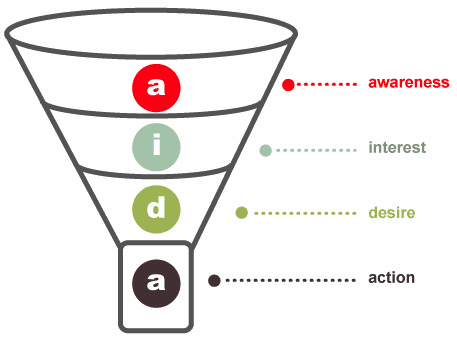“Great storytelling isn’t easy, but if done well, it can be more powerful and motivating than any other kind of content.”
Andrew Davis, best-selling author of “Brandscaping: Unleashing the Power of Partnerships” made this statement last week when he took to the stage for Content Marketing World 2014. In fact he shared a number of valuable insights, but four secrets in particular are worth their weight in gold.
Before we get to the ‘how’, it’s important to first understand ‘why’ – why storytelling is valuable and why
Moments of Inspiration lead to Return on Investment.
 Davis highlighted that we have a funnel problem. He referenced the diagrams by Elias St. Elmo Lewis (circa. 1898) with the intent to show the factors that drive consumers to buy – that these days instead of thinking like consumers, marketers keep reinventing the funnel.
Davis highlighted that we have a funnel problem. He referenced the diagrams by Elias St. Elmo Lewis (circa. 1898) with the intent to show the factors that drive consumers to buy – that these days instead of thinking like consumers, marketers keep reinventing the funnel.
Websites, whilst incredibly important, are not the first port of call for a consumer online; Google or “search” is.
Davis illustrated his point through a typical search, which in this case is the journey of Meatloaf. In a Moment of Inspiration, a Google search for comfort food led him to 2,200 images of meatloaf from which he thought, “I’m hungry for meatloaf”. What came next was the Trigger where he decided “I’m going to make Meatloaf for dinner”. Then came the Initial Consideration Set of “Allrecipes.com must have good meatloaf recipes” where he found one recipe with 22,000 people rating it four stars and thought “This must be a good one”.
But it didn’t end there, next came the Active Evaluation:
1. “I’ll check Yelp to see what’s available in town first.” The reviews didn’t offer anything impressive.
2. “I’ll Youtube how to make Meatloaf”. The ten-minute tutorial suggested researching for a good Meatloaf pan.
3. Searches Amazon for a Meatloaf pan.
4. Wonders how many calories are in meatloaf. Discovers there are over 1,000 calories.
5. Joins the “Meatloaf sucks” Facebook group.
6. Looked for references to meatloaf on Twitter, which included Meatloaf, an artist he likes.
Then came the Moment of Purchase …Davis purchased tickets to Meatloaf and is right back where he started.
Many companies are great at the point just before the Moment of Purchase when people are actively comparing their brand amongst others, but there is far more value in creating moments of inspiration that trigger irresistible acts in the mind of the consumer.
Davis referenced Chuck Williams, founder of Williams-Sonoma, who once said, “We don’t sell the drill or the drill bit, we sell the hole.” When the company distributed thousands of catalogues showcasing expensive, premium cuts of meat, but received very little response, Williams demanded to see a copy and was in turn livid. “Who wants to eat a raw piece of meat? People don’t want to eat raw meat, they’re inspired by steak,” he said. “This is what people want.”
It brings us back to the point that Moments of Inspiration lead to Return on Investment, and achieving this can be done through these four considerations:
1. Build suspense: Create anxiety about what will happen.
Breville, an Australian maker of high-end juicers, sponsored a Netflix series called “Fat, Sick and Nearly Dead,” about an obese man trying to lose weight. When the series started airing, it prompted a wave of inspiration and Breville Juicers sold out worldwide. Davis suggested, “Ask yourself, ‘Is there inherent suspense in the story I’m telling?'”
2. Foster Aspiration: What does my audience aspire to do or be?
When DCVelocity.com, a specialised website for logistics & distribution centers, started posting a half-hour show called “Move It”, which took viewers on a factory tour, the show not only boosted sales of belt sorters and other specialised equipment showcased, it was also picked up by Japanese public television.
3. Drive Empathy:
IBM was transitioning from a manufacturer to a service provider in 2011 and created a robot named Watson to facilitate understanding. Watson could play “Jeopardy!” and IBM challenged it to beat two human trivia champions. The interesting response from viewers was not that they cheered for the robot, but that they felt bad when it missed a question.
IBM created content around it, and Nova created a PBS special called, “The Smartest Machine on Earth. Following the special airing, IBM witnessed a boost in calls asking for its expertise, which sparked a 20% revenue surge in a single quarter. IBM continued to leverage Watson as a content generated for many years after that.
4. Harness emotion: Harness emotion and you’ll inspire people to act.
When a Danish TV show called “Arvingerne [the Legacy]” showed the heirs of a matriarch squabbling over her inheritance, viewers started calling lawyers about creating wills and estate-planning.
“Stop creating campaigns, and start making a commitment to tell a valuable story – a story that’s bigger than you,” Davis said. That’s more important than how many likes, favourites or followers somebody has.
Davis concluded by asking what emotion inspires action that relates to your product or service, and this is our reason for sharing. At underscore we approach every branding project with a goal to get an appropriate emotional reaction from our clients’ audience that can achieve immediate cut through and helps us to build a customer relationship for the longer term.
Brought to you by an underscore thought leader:
Rachael Bradley, Strategic Account Executive.
Original Source: Janet H. Cho
From Andrew Davis at Content Marketing World 2014
Image Source
